playing in position pt. 2: physiological compromises
Because “everyone’s bodies are different, and guitars vary in shape and size,” I’ve expressed skepticism that playing in position was a “more efficient or comfortable playing technique.” Let me elaborate on that (not at all straightforward) relationship between position playing and physical comfort here. Also, keep the following discussion in mind for when we return to looking at natural harmonics.
My usual disclaimer. Specifically:
I have no knowledge of your physiology, your particular instrument, or your posture. Please, please, please, note that the following may not be applicable to your situation, and, at best, should be adapted to fit your your needs. Be careful and listen to your body: If it hurts, or it’s uncomfortable, stop and review.However, in very general terms, in approaching this material, your whole fingerboard-side arm should have mobility. If your elbow cannot swing around comfortably, you’re probably not doing this right. A common mistake is to make these fingerboard shapes while attempting to keep your forearm frozen, resulting in having to twist and contort your hand/fingers.
The orthodox shape of the fingerboard hand at rest is colloquially described as ‘finger-per-fret.’ The shape corresponds roughly to that of a hand holding a pencil.
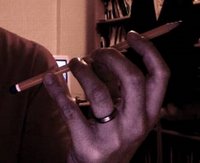 (Incidentally, note that the thumb is not opposite the first finger. Contrary to some accounts of how the guitar’s neck should be held, you may find it is uncomfortable if the thumb directly opposite the first finger.)
(Incidentally, note that the thumb is not opposite the first finger. Contrary to some accounts of how the guitar’s neck should be held, you may find it is uncomfortable if the thumb directly opposite the first finger.)That should be reasonably comfortable, but unlike a pencil, the guitar strings are not as freely rotated or repositioned.
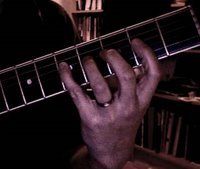 The orientation and location of the fingerboard hand will depend on multiple factors. Even at best, the result is to some extent a compromise: Trading off the comfort of your fingerboard hand and arm against your picking hand/arm, your back, legs, etc. Before you go and radically rethink your posture, it’ll be instructive to think what might be the most comfortable fingerboard shape.
The orientation and location of the fingerboard hand will depend on multiple factors. Even at best, the result is to some extent a compromise: Trading off the comfort of your fingerboard hand and arm against your picking hand/arm, your back, legs, etc. Before you go and radically rethink your posture, it’ll be instructive to think what might be the most comfortable fingerboard shape.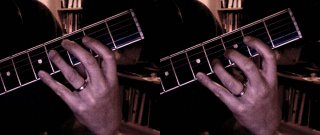 In practice, the most comfortable position for the fingerboard hand will likely resemble something like the shape above, left. Or, clearing-up and abstracting a general shape, something like the above, right. This is a diagonal fretting pattern that, from first to fourth finger, moves bass to treble across the strings, and bass to treble up the frets.
In practice, the most comfortable position for the fingerboard hand will likely resemble something like the shape above, left. Or, clearing-up and abstracting a general shape, something like the above, right. This is a diagonal fretting pattern that, from first to fourth finger, moves bass to treble across the strings, and bass to treble up the frets.Even if you’ve never explicitly encountered this oblique fingerboard pattern, it lies at the root of both the ‘chord’ (perpendicular to the strings) and ‘finger-per-fret’ (in-line with the strings) shapes.
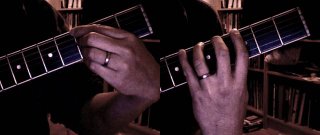 The shape that is perpendicular to the strings (above, left) is under theorized, but will be familiar if you think about the fingering of chords. (The algorithm for finding the fingering pattern for chords is, from first to fourth finger, (a) move bass to treble up the frets unless you need to stop two or more string on a given fret, in which case (b) bass to treble across the strings. Does this resemble anything we’ve already covered?)
The shape that is perpendicular to the strings (above, left) is under theorized, but will be familiar if you think about the fingering of chords. (The algorithm for finding the fingering pattern for chords is, from first to fourth finger, (a) move bass to treble up the frets unless you need to stop two or more string on a given fret, in which case (b) bass to treble across the strings. Does this resemble anything we’ve already covered?)If we consider the diagonal fingerboard shape as the rest position, we can consider these others as extremities. From the diagonal shape, we can rotate the fingerboard arm about the first finger to achieve, in one direction, the in-line shape, and, in the other, the perpendicular shape.
If we understand these as the extremities, we can also understand why the reversed diagonal shape (below), for example, is, depending on your posture, difficult (please do not over do this one):
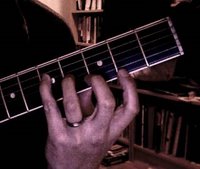 Okay, why all this information? Understanding what shapes are more comfortable and what is less, helps us understand why certain patters are easier to play than others. Specifically, when we return to natural harmonics, when we start discussing clusters, or two handed touch/tapping, we’ll come back to these ideas. In effect, becoming aware of the physiological-physical interface and its pressures and compromises, we are taking our first baby steps towards becoming consciously engaged in the cyborg relationship between humyn (guitarist) and artifact (guitar).
Okay, why all this information? Understanding what shapes are more comfortable and what is less, helps us understand why certain patters are easier to play than others. Specifically, when we return to natural harmonics, when we start discussing clusters, or two handed touch/tapping, we’ll come back to these ideas. In effect, becoming aware of the physiological-physical interface and its pressures and compromises, we are taking our first baby steps towards becoming consciously engaged in the cyborg relationship between humyn (guitarist) and artifact (guitar).

No comments:
Post a Comment